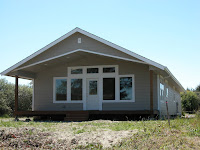On many occasions while showing new houses out on the beach, some buyers take the approach that they would rather get a loan to buy a vacant lot, then hire a local builder to build them their beach getaway. There are several differences when it comes to the financing options between purchasing an existing home or buying a lot and having a home built on it. I recently sat down and talked to Carol Warfield, loan officer with the Bank of the Pacific about some of the differences.
The first is the required down payment
On a conventional construction loan, you must invest 20% of the cost of the entire project, which would include land purchase and prep, cost of plans, plan review, building permit, well and septic design & permits if applicable, cost of construction including builders overhead, sales tax, etc. All closing costs on a construction loan are in addition to the 20% investment in the project itself, and generally run more than closing costs for a purchase loan.
With a construction loan, you can almost always count on two things - it will take longer and cost more than you expect. Another thing to watch is change orders. Once your construction loan is in place, 100% of the cost of change orders comes out of your pocket.
On a purchase loan you know up-front what your costs will be. You will pay the required down payment, plus closing costs. There are many types of loan programs available for purchase loans - Conventional, FHA and USDA are among the most popular.

The second difference is interest rate
Single-close construction loan interest rates typically run about 1/2% higher than purchase loans interest rates. With either type of loan, you lock in an interest rate prior to closing the loan. On a construction loan, you pay interest monthly on the amount you’ve drawn during construction, and then the loan converts to a 15 or 30 year fixed rate loan, with principal and interest payments once construction is complete. You pay the same interest rate during construction and during the long-term loan. Because the interest rate is “locked in” prior to the home being built, the investor takes some risk by guaranteeing you that interest rate once construction is complete, so they tend to price them a little higher. The other potential hazard is that if you don’t complete construction in the allotted time-frame, you would either lose your interest rate lock, and get whatever the going rate is at the time construction is complete, or pay a fee to extend the interest rate lock.
On a purchase loan, the rate lock period is generally 30-45 days, just enough time to close the loan, so investors are more likely to price at current market rates. Once you’ve closed your purchase loan, there is no risk of losing your rate lock.

Another difference is the risk and hassle factor
A purchase loan is a pretty easy loan to process and close. All required documentation is gathered up front, generally two years income verification (tax returns and/or W-2s), two months recent paystubs, and two months recent asset statements. If you have non-wage income, you may be asked to supply verification of that information also, such as lease agreements on rental properties, trust agreements, child support, annuity or investment income, etc. Once your credit report is pulled, it is not a common practice to need an updated report before the loan closes.
On a construction loan, all the same documentation is required up front, plus all the construction-project paperwork. Once construction is complete, some investors are requiring updated credit report and income documentation. I’ve seen instances where credit has deteriorated and income was reduced, causing the loan to no longer fit the program for which it was originally approved, sometimes making the loan ineligible for secondary market purchase. Then the loan would revert to a portfolio loan at a higher interest rate.
If you have any questions regarding new construction, new homes or builders in the Ocean Shores/North Beach area, please contact Jeff Daniel/Associate Broker with
Whether you’re looking a home loan, construction loan or refinancing, please contact Carol Warfield at 360.537.4044.
Carol started with Bank of the Pacific in 1997 as a branch manager and has been originating home loans since 2004. Carol has over 20 years of banking experience which includes helping customers buy, refinance, and build their dream homes. With her vast experience and dedication to each customer, Carol ensures your transaction will go smoothly.
















0 comments:
Post a Comment